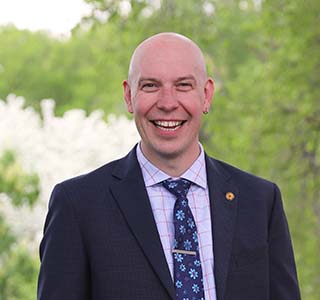Ryan Torma
What makes a great learning experience?
Ryan Torma says he’s lucky to have had many. But one particular experience stands out: his participation in choir as an undergraduate at the University of Minnesota. Torma says his choir director “helped me develop as a musician, which is a big part of my life. She was demanding and very supportive at the same time; she was after excellence and really helped us get there.”
When he arrived at the U of M, Torma brought a similar inclination toward excellence to the College of Continuing and Professional Studies, where he is the executive director of Professional Development and Lifelong Learning, which includes Conferences and Professional Development Programs, and Osher Lifelong Learning.
Torma aims to apply his considerable expertise in instructional design and adult and distance learning to help make higher education more accessible and affordable.
Minnesota born and raised, Torma holds a doctorate of Education in Higher Education Leadership from Bethel University, where his research focused on design thinking as an approach to solving complex problems in higher education. He earned a master of arts from Luther Seminary, where he studied the intersection of media, meaning, education, and technology; his bachelor of arts degree is from the University of Minnesota School of Journalism.
Torma most recently served as assistant dean of Online, Distance, Adult, and Continuing Education at Valparaiso University in Indiana. He says he’s looking forward to returning to the Land of 10,000 Lakes. “Minnesota is home to me,” he says. “I’m excited to be coming home.”
In a recent conversation, Torma shared his vision for the College and why he’s looking forward to working at the University of Minnesota.
What drew you to the U of M?
The U of M is uniquely positioned to do great things. It’s a well-respected research institution in the heart of a growing, thriving metropolitan area, poised to create opportunities not available to everyone in the country. The U of M is a leader in creating high-quality professional development and continuing education programs, and there is a great team working to support programs, conferences, instructors, and students. I’m excited to join a great team and to continue to develop the great work that is happening at the University.
How do you measure a good learning experience?
There are many ways to define and measure student experience. One way is to look at outcomes: Did students develop knowledge and skills that are meaningful to them and help them to obtain their goals and advance in their careers? This is often measured by looking at how students demonstrate their knowledge and skills through course assignments and by asking students how the learning made a difference in their career and life.
Another way to measure student experience is to find out if students enjoyed the learning experience. There are many ways to measure this but mostly it involves asking students about their experiences, through conversations, focus groups, surveys, and social media.
The college offers both online and in-person learning experiences. How are they different, and how do you make sure students have great experiences in both?
The great thing about online learning is flexibility, the ability for people to take a course when it’s convenient for them. Online learning provides flexible learning experiences that can include web-based video lectures and interaction, online discussion through email, discussion boards, web-based video chat, and even self-paced learning activities. The variety of modes of interaction can make it easy for people to fit online learning into their busy lives.
Of course, in-person learning makes it easy for people to interact with one another in real time. In-person learning provides great opportunities for discussion, interaction, and team-based collaboration.
In each modality, it’s possible to create great moments of interaction, feedback, and collaboration.
In order to provide great learning experiences, it’s important to design the experience specifically for the mode in which the student will participate in the learning.
The U of M is uniquely positioned to do great things. It’s a well-respected research institution in the heart of a growing, thriving metropolitan area, poised to create opportunities not available to everyone in the country.
How can design thinking be applied to planning professional development courses at the U of M?
Design thinking is a collaborative and creative process in which we bring together multidisciplinary teams to understand what people’s needs are and then design and develop solutions that address those needs.
I’ve been led in a variety of design thinking-based projects to design things such as new programs oriented to the changing world of work, digital and physical learning environments which support the unique needs of adult students, and student orientation processes that help students to be successful in starting their programs.
I’m looking forward to working with the CCAPS team to explore how we might use design practices to create great courses, programs, events, learning environments, and support services for our students.
What are you most looking forward to in your role as executive director of Professional Development and LearningLife?
I’m excited about how professional and continuing education provides robust learning experiences throughout people’s lives. The way we do work is changing, and professional education is a way for people to develop skills to be able to thrive in the changing environment. The U of M offers many exciting opportunities to learn and grow professionally through conferences, courses, certificates, and boot camps. Professional development allows people to have learning experiences that are the right size at the right time. And not just through professional development, but also through the U’s lifelong learning programs—LearningLife, Encore Transitions, and Headliners—through which the vast resources of the U of M are made available to a broader audience.

